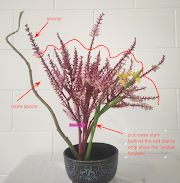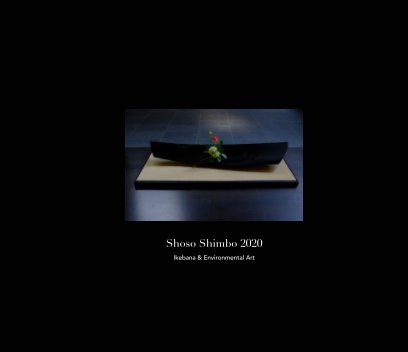Beyond Design Principles- Level 3.5 Form X Balance ( 2 November 2024)
Always remember that you are aiming to go beyond simply designing an ikebana work to create ikebana through meditation. Following the three-step learning model is recommended: start with a small aspect of design (Form X Balance in this session), think deeply about all aspects of design (Review Level 1 & 2 in Zoom Ikebana Dojo) until new ideas emerge, and then follow the direction of your new ideas to find poetry in your work.
During this kind of creative meditation, it is hoped that you will be able to learn to talk to the flowers rather than thinking about designs analytically (Refer to Dr Shimbo's essay, A Flower Arrangement in Search of Poetry).
In this session, 3.5: Form X Balance, please start by making more than 2 massed forms using flowers (or berries, buds etc.), and develop your design focusing on balance.
As we learnt in Balance 2, it is asymmetrical balance rather than symmetrical balance that we would like to achieve in our ikebana work. Asymmetrical balance is visual equilibrium of a composition not dependent on one side mirroring the other. We have discussed several important strategies to achieve it in Balance 2. Of course you are welcome to explore your own strategies. Following is an example of a basic creative process.
Process of Creative Meditation in Form X Balance
- Make 2 or more massed forms using flower materials. You may use the same material or different materials.
- Think of their relationships. Do they want to be close or be apart?
- Think of their position in relation to your container. Think of many options.
- Can you feel their energy? Meditate on the stories they might tell. Their story can be very simple, i.e. “we are like mother and child, and the child wants to be independent now.” This meditation may help shift your thinking from design focused analytical thinking to deep thinking.
- Introduce other elements (line, form, space or colour) to visualise their stories. Review what you learned in Four Ikebana Elements in Zoom Ikebana Dojo.
- Check asymmetrical balance.
- Check your work in terms of other design principles, i.e., movement, contrast and pattern. Review what you learned in Four Ikebana Principles in Zoom Ikebana Dojo. You may not be able to apply all of the principles but trying to incorporate some of them may help improve your work.
- Meditate on your work with your selfless mind, without thinking about designs. Make adjustments to reveal a new life (harmony or poetry) in the arrangement.
- In some Ikebana workshops in Australia, you may hear comments such as "you failed because you did not show contrast well." That is not our approach. That is not how we learn ikebana in Japan either. We value design but we aim to go beyond design. In Level 3 our goal is to achieve harmony, which is higher than design in our definition.
What's Next? - Get Feedback
1. Book to join Zoom Ikebana Dojo by the deadline. That is the first step. Follow the instruction on the page.
2. After receiving confirmation of your booking, we send you links to access our video tutorial & our Zoom session. Our detailed video (members only) will help you analyse sample works, and help you make your Ikebana work.
3. Make your own work and send the image of your work to Zoom Ikebana Dojo (ikebana.dojo@gmail.com).
4. Join Zoom Ikebana Dojo. Enjoy friendly feedback from our facilitator and other participants.
5. Rework your ikebana after the Zoom session.
6. Post your work to Ikebana Gallery Award.
News: Application has opened for Level 3, Part 2 (3.5 ~ 3.8). Check prerequisites and Book now. Learn Ikebana as Meditation.
References
Shimbo, S. (2021). Ikebana: Flower Arrangement in Search of Poetry, Garland Magazine.
























